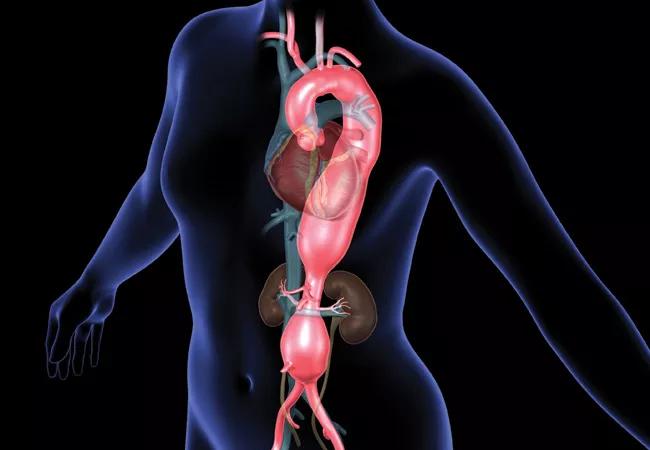Advertisement
Large series strengthens case for timely prophylactic intervention

Despite its malignant prognosis, the connective tissue disorder known as Loeys-Dietz syndrome (LDS) is far from being unmanageable. That’s the takeaway of a retrospective review of a cohort of patients with LDS — one of the largest analyzed to date — reported by Cleveland Clinic researchers May 1 at the AATS annual meeting and simultaneously published by the Journal of Thoracic and Cardiovascular Surgery.
Advertisement
Cleveland Clinic is a non-profit academic medical center. Advertising on our site helps support our mission. We do not endorse non-Cleveland Clinic products or services. Policy
“We found that intermediate-term outcomes of prophylactic aortic surgery for LDS are excellent,” says cardiothoracic surgeon Lars Svensson, MD, PhD, Chair of Cleveland Clinic’s Miller Family Heart & Vascular Institute and the study’s senior investigator.
LDS is a recently recognized disease entity, identified in 2005 as an autosomal dominant connective tissue disorder caused by mutation in two transforming growth factor β receptor genes. It’s often characterized by early presentation of aortic dissection and rapid progression of aneurysmal dilatation if not treated prior to dissection.
Although understanding of LDS has advanced notably since 2005, data on the surgical outcomes of affected patients have been scarce. “During the past decade, we developed a registry of LDS patients at the Aorta Center within Cleveland Clinic’s Heart & Vascular Institute,” Dr. Svensson notes. “We used that registry to review and report our experience with LDS to clarify its natural history and outcomes of surgical intervention, with an eye toward helping establish treatment guidelines.”
Dr. Svensson and colleagues identified all patients with LDS who underwent medical or surgical management at Cleveland Clinic through April 2017. Primary outcomes evaluated were postoperative in-hospital morbidity and mortality; secondary end points were aorta-related reoperations and short- and long-term mortality.
Of the 53 patients with genetically confirmed LDS included in the analysis, 33 (62 percent) underwent aortic surgery and 20 had not required aortic surgery as of last follow-up. The latter 20 patients were treated medically (aggressive blood pressure control to minimize aortic wall stress) and received ongoing clinical and radiologic surveillance; these patients constituted the “non-aortic surgery group.”
Among the 33 patients who had aortic surgery, mean age at the index operation was 39 years (four patients were younger than 18) and maximum aortic diameter was 4.3 cm. Among the 20 patients in the non-aortic surgery group, mean age was 23 years and maximum aortic diameter was 3.4 cm.
Within the 33-patient aortic surgery group, notable findings included the following:
Advertisement
There were no deaths among the 20 patients in the non-aortic surgery group, who underwent median follow-up of 8.4 years.
“These findings show that although the need for surgical reintervention in LDS patients remains high, especially after aortic dissection, outcomes of prophylactic aortic surgery are excellent through the intermediate term,” observes Dr. Svensson.
The series also shows that aorta-related reoperation is more widespread among patients who had initial aortic surgery for an acute type I dissection, he adds. Of the patients who had multiple aortic interventions, 82 percent had a history of acute aortic dissection.
“These data suggest that a timely prophylactic aortic operation helps tame the aggressive natural history of LDS,” Dr. Svensson says. “In our prior report of prophylactic modified valve-sparing root repair in 178 patients with connective tissue disorders (Ann Thorac Surg. 2013;95:555-562), we demonstrated safety with no operative deaths as well as 92 percent freedom from aortic valve reoperation at six years.”
The series’ large share of patients (38 percent) who were successfully managed medically over many years of monitoring underscores the importance of multidisciplinary care that recognizes the need for lifelong management of LDS, Dr. Svensson notes.
“Our Aorta Center and our Marfan Syndrome and Connective Tissue Disorders Clinic stress the need for close collaboration among cardiologists, cardiovascular surgeons and geneticists to properly care for patients with LDS,” he says. “That type of interdisciplinary approach is essential for the early recognition, close monitoring and timely prophylactic surgery required to prevent catastrophic complications in these patients.”
Advertisement
Advertisement

Surprise findings argue for caution about testosterone use in men at risk for fracture

Findings support emphasis on markers of frailty related to, but not dependent on, age
![GettyImages-1252287413 [Converted]](https://assets.clevelandclinic.org/transform/StoryPanel/350804b2-f1e4-4d97-a277-9629cf45af3e/23-HVI-4120348_redlining_650x450_jpg?w=3840&q=75)
Large database study reveals lingering health consequences of decades-old discrimination

Additional analyses of the two trials presented at 2023 ESC Congress

Prospective SPIRIT-HCM trial demonstrates broad gains over 12-month follow-up

An ACC committee issues recommendations to accelerate sluggish progress

Review of our recent experience shows it’s still a safe option

Machine learning may improve risk prediction and guide therapy